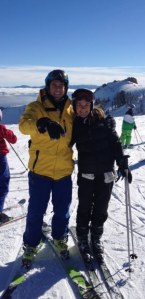 Olympic athletes have trained their bodies to near perfection by the time they arrive in PyeongChang for the 2018 Olympics. However it is the mental preparation for the pressure that comes with competing at the 2018 Olympics that is critical, and may ultimately determine a gold versus silver medal. Visual imagery has long been a part of the training regimen of elite athletes and has become increasingly more utilized across the world.
Olympic athletes have trained their bodies to near perfection by the time they arrive in PyeongChang for the 2018 Olympics. However it is the mental preparation for the pressure that comes with competing at the 2018 Olympics that is critical, and may ultimately determine a gold versus silver medal. Visual imagery has long been a part of the training regimen of elite athletes and has become increasingly more utilized across the world.
The US Olympic team traveled with nine sports psychologists this year to help athletes with overcoming fears and visualizing success. Being able to envision success is critical to achieving such goals for athletes. US team sports psychologist and professor at Univeristy of Utal, Dr. Detling states, “You are training those muscles, and if you are training those muscles to fail, that is not really where you want to be. So one of the things I’ll do is if they fail in an image, we stop, rewind and we replay again and again and again.”†
Visual imagery is a mental training technique which involves the athlete creating a picture of their sporting event in their minds. Visual imagery can be used for the following:
-Increase confidence before competition
-Help with healing and recovery
-Improve relaxation between events
-Reduce discomfort and muscle inhibition that comes from intense physical demands
-Overcome prior mistakes and fears of failure associated with past errors
Here is a highly effective visualization exercise to help mentally gear up for the performance of a lifetime—whether you’re a dancer, high school baseball player, swimmer, avid runner, or recreational tennis player. Spending just a few minutes before any big event just may give you that extra winning edge!
- Find a quiet place and sit comfortably with your eyes closed. Start by imagining yourself just before your event. Picture yourself approaching the starting line, climbing up onto the diving block, getting into position, lining up with your teammates, etc.
- Take a deep breath and begin to notice the sounds you hear around you
- What do you see? What’s happening around you?
- What do you smell?
- Notice the sensations inside your body and on your skin.
- Take another deep breath and let the event begin! Picture yourself as if watching a movie. Watch yourself spring into action—it’s your best performance ever! Pay attention to the sensation of your flexing muscles and the movement of your body. Note all of the sensations, sights, sounds, and smells as you push your body to its limit.
- Take another deep breath as you gear up for that final push. You may even feel your heart rate and breathing speed up a bit as you imagine the exhilaration of this moment.
- Finally, imagine your big win. Listen to the crowd cheer and feel the congratulatory pats on your back. Allow the emotions to bring a smile to your face and congratulate yourself on your best performance ever!
- Take one last deep breath and open your eyes.
This exercise is really easy and well-worth the few minutes it takes to do. Creating successful mental imagery requires practice and patience. To learn more about how to practice this technique and the power of mental preparation before an athletic event, here are a few links to articles we think you might enjoy:
Huffington Post Article on 5 “Mind-Hacks” for Performance
Psychology Today article about Sport Imagery
A Peer-Reviewed Article from the Sport Journal on Performance Strategies
New York Times Article on Sports Imagery
†Source: Clarey, Christopher. “Olympians Use Imagery as Mental Training” New York Times. Feb 2014. Link to Article.




